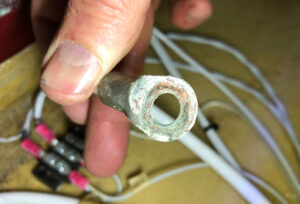Since the first day I flew my GlaStar, the starter has caught, swung the prop to the next compression stroke, where it almost stopped, and then continued on its way. Never has the airplane not started. So far.
But this hesitation has always bothered me, making me concerned that the right combination of slightly weak battery and cold temps will leave me stranded. So while I had the airplane partially disassembled for the annual condition inspection, I decided to investigate a bit further.
For some reason I had assumed that this GlaStar was built using a method familiar to some builders, which is to connect the negative terminal of the battery to the cage at the rear (where the battery usually is) and then the ground connection to the engine, typically from one of the engine mount lugs forward of the firewall. This seems clever: Let the cage be the ground path. But this method is dependent on really good electrical bonding between the cage and the terminals at each end. Based on anecdotal experience, when I built my previous Sportsman, I elected to run a separate, large-gauge ground wire from the battery to the firewall, connecting to the cage, then then to the engine. Even though the Sportsman had a normal-compression IO-390 (and the GlaStar has a low-compression O-320), the Sportsman’s system spun the prop with real vigor. Yeah, the separate ground wire was a little heavier but I deemed electrical reliability worth the cost.
Turns out, though, this GlaStar also has a separate ground lead. Dang, I though that was going to be the issue! To eliminate other potential causes, I made sure the battery was fully charged—and it is only a couple of years old—before I pulled the first panel, but once I did, I knew that I’d found at least a partial culprit. As you can see from the photos, there was significant corrosion on the negative battery terminal. (The positive terminal was clean.) Ah-ah. That has to be it.
So I thoroughly cleaned the terminals and mounting post, and reassembled. I used the tried-and-true baking soda/water combination to neutralize the corrosion. I didn’t have any petroleum jelly at the hangar but did have a tube of dielectric grease, which I used instead to protect the terminal. I hit the positive terminal with some of that as well.
Success? Um, not 100%. Better, definitely better, even swinging the prop on a cold-for-Portland morning. But there’s still the hitch in the start sequence that makes the OCD in me go a little haywire. As the annual progresses, I’ll follow the ground path all the way to the engine and double-check all of those connections. Like so many things in aviation, most maladies (real or imagined!) are the result of a chain of things, not one miscue or fault. Bottom line, though: Mind your terminals!













